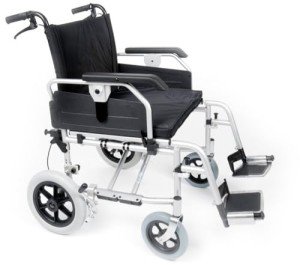Bariatric Wheelchair Seat Width
Seat Width

Having the appropriate seat width is very important to wheelchair users who spend longer periods in their chairs. Too narrow a seat will trigger pressure on the hips and thighs which might lead to sores or pressure points. Having too broad a seat can likewise make it challenging for the user to reach the hand rims to propel themselves or maneuver in small spaces.
To determine the correct seat width a person would rest on a chair normally and have their measurement taken across their lap at the widest point which is usually their hips. A wheelchair determining tape can be used to determine this, however a lawn stick is preferred as it avoids individuals from covering the tape around their hips which would give an inaccurate result.
The basic wheelchair seat width is 16" (narrow adult), 18" (standard grownup), and 20" (broad adult). For bariatric patients, a 24" seat is offered. This heavy-duty extra wide bariatric wheelchair from Medline includes swing-away footrests, a carbon steel frame with rust- and chip-resistant chrome plating, and easy-to-clean vinyl upholstery. It has a weight capacity of 500 pounds.
Seat Depth
Generally, the seat depth of a bariatric wheelchair was added 2" to the measurement taken at the user's largest point (usually their hips). This was implied to accommodate extra layers of clothes that may be used throughout cold weather. Nevertheless, this practice is becoming less common as wheelchair users have the ability to invest more time indoors and are not using long coats. This makes the seat depth of a chair less essential when choosing a bariatric wheelchair . Nevertheless, it is still essential to pick an option that uses adequate support for bigger users.
The Medline folding extra wide bariatric manual wheelchair includes a comfy 24" seat width and a heavy-duty slide tube silver vein frame. It likewise has an adjustable axle and tool-free elevating legrests.
Seat Height
When it comes to determining the correct wheelchair seat width you should constantly measure from the user's best point which is normally their hips. You will likewise require to consider whether the user is going to be wearing a winter coat as this might add 2" to the width needed.
When a wheelchair remains in use it must only be run on level surfaces with the wheel locks fully engaged. This is to prevent the chair from being able to move inclines that are 10 degrees or higher. It is also essential to keep in mind that any activity that may shift the center of gravity in the chair ought to be made with care. This includes grabbing products that need the person to lean out of their seat or attempting to stand from it.
Whenever you have the chair in usage it is advised that you routinely examine it for damage and lube any locations that are considered necessary. For example, the casters should be oiled by removing the caster fork and using a multi-purpose grease to use to the caster stem bearings. Similarly, the foot plates can be adjusted by loosening up the bolt and then moving them to the preferred position. This enables the feet to sit easily on the footplate and avoids any pressure points from forming. This can be extremely unpleasant for the user and if left unattended, can result in pressure sores.
Weight Capacity
Bariatric wheelchairs are created to support more weight than basic wheelchairs. This makes them tougher and much better equipped to manage falls. They are likewise normally bigger and larger, making them less maneuverable in tight spaces than basic wheelchairs. They require lorries with unique ramps and lifts to pack them, along with motorists who know how to finest transport them from one place to the next.
When selecting a wheelchair, consider its weight capacity as it will be the main determining element in whether it will accommodate your traveler's needs. The weight capacity of the chair is often noted as a static load, suggesting that it shows the amount of weight the chair can easily hold while standing still. However, some manufacturers also note an active load that is based on a drop test and can imitate the effect of somebody sitting down in the chair. This may be a more reputable measurement of the weight limit, depending on your needs.
If bariatric wheelchairs prepare to carry out activities that shift your center of gravity in the seat (such as grabbing items), make sure to have front casters pointed in a forward direction and wheel locks engaged so the chair will not topple. Likewise, inspect that casters are oiled routinely to avoid extreme wear and abrasions. The lubrication treatment includes removing the fork, separating the caster from the wheel, and greasing the caster stem bearings with top quality multi-purpose grease.
